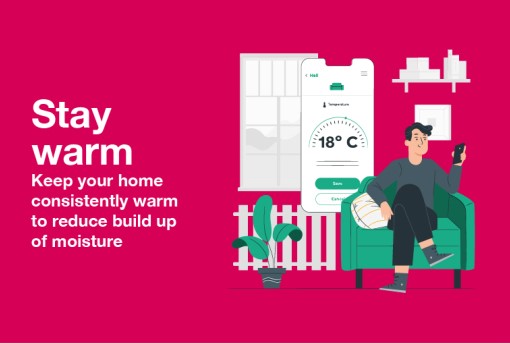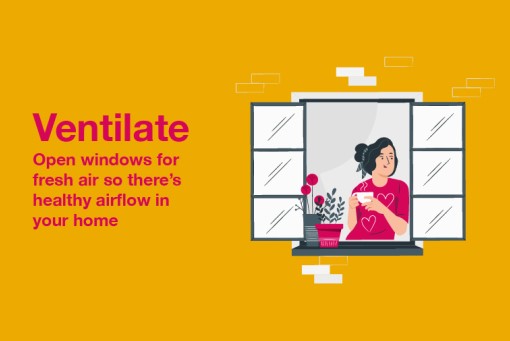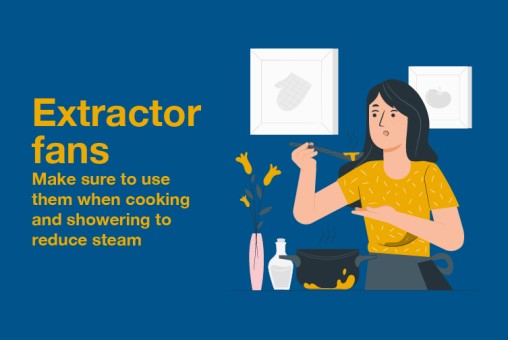Damp, mould and condensation
Worried about damp or mould in your home?
We take damp, mould and condensation seriously, as your safety is our to priority. Please report any signs of damp and mould as early as you can.
Find out more about what causes it, what you can do and how we can help below.
What is Awaab’s Law?
On 27th October 2025, Awaab’s Law comes into effect. It’s named after Awaab Ishak, a two year old who tragically died in 2020 due to ongoing exposure to mould in his social housing home. Awaab’s Law holds housing associations to strict timescales for dealing with certain health and safety hazards, like damp and mould. For example we must investigate reports within 14 days and begin necessary repairs within 7 days of investigation where there’s risk of serious harm.
Working in partnership to tackle damp and mould
We’ve been preparing for the new introduction of Awaab’s Law for the last year and have been putting processes in place to work with you to tackle damp and mould issues.
Damp and mould cases are raised separately from general home repairs on MyRaven, this helps us prioritise and makes it easier for you to see the timescales and progress.
When you raise a damp and mould case we’ll:
- work together as tenant and landlord to look at options and agree an action plan
- produce a clear schedule of works for remedial action
- provide real-time updates through your MyRaven online account
- ensure long-term results by carrying out follow up checks at six weeks and 12 months after any remedial work has taken place.
Understanding damp, mould and condensation

Damp
Caused by a number of things, such as: leaking pipes and drainage, leaking roof coverings or blocked gutters, lack of damp proof course, condensation

Mould
Mould grows when there’s excess moisture. It might appear black, white, yellow or green in colour. Mould can increase the risk of asthma and respiratory illnesses in some people and must be dealt with urgently.

Condensation
There’s always some moisture in the air, even when you can’t see it. If the air gets colder, it can’t hold all the moisture and tiny drops of water appear. This is condensation. You’ll mostly see condensation build up on windows or external walls where the moisture meets the coldness of outside.
What you can do at home
Condensation build up can lead to damp and mould in your home. You’ll mostly see the signs of condensation in kitchens and bathrooms. The moisture comes from typical day-to-day activities including washing, cooking, drying clothes, showering and bathing.
There are little things you can do each day to reduce the risk of mould developing:

Heat your home
Winter is known as the condensation season, when temperatures are colder outside and the house is cold the air can’t hold all the moisture. When the home is warmer, condensation is less likely to appear.
- Keep rooms warm enough to avoid condensation. Keep low background heating on all day (this also saves energy costs as you don’t have to keep heating a cold home from a very low temperature)
- Install carpets and curtains where you can to help keep your home warm and well insulated
- Don’t use paraffin or bottled gas heaters to keep your home warm as these are a fire risk
If you’d like advice on the cost of heating your home please contact the Energy Saving Trust on 0300 123 1234. If you’d like advice on managing your energy bills or energy tariffs, please contact our Moneywise team through your MyRaven online account or by calling 0300 123 3399.

Ventilate to remove moisture
Ventilation in a home is important to get rid of the moisture that is naturally created through day-to-day activities.
- Keep trickle vents on your windows open at all times or leave a small window slightly open
- Close the bathroom and kitchen doors when these rooms are being used, even if they have extractor fans, to stop the moisture reaching other rooms and open windows when cooking if possible
- Allow space for air to move around your furniture. Open doors regularly to ventilate cupboards and wardrobes, leave space between the backs of furniture and the wall Wherever possible position furniture against internal rather than external walls
- Don’t overfill wardrobes and cupboards as this will stop air from circulating

Produce less moisture
- Use extractor fans in kitchens and bathrooms
- Cook with pan lids on and turn the heat down once the water has boiled
- Use the minimum amount of water needed to cook vegetables, pasta, rice or potatoes on the hob
- When filling the bath, start with cold water then add the hot (this reduces the amount of steam created)
- If you use a tumble dryer, make sure this is vented to the outside or it is a condenser dryer
- Reduce moisture by using a dehumidifier, these can be electric or use crystals
- Avoid drying laundry on radiators. Dry clothes outdoors whenever possible. If you do have to dry them inside, put them in the bathroom on an airer with the door closed and the window open or extractor fan on
- Don’t use your gas cooker to heat your kitchen and don’t use bottled gas heaters
Need help with tackling condensation?
If you’re not clear what to do to reduce condensation in your home, we can visit and give you advice as well as check for any repairs. We can give you more detailed information about the right paint to buy, dehumidifiers, airers and ways to clean mould.
If you’re struggling financially, we may be able to get you help with the cost of buying items to deal with condensation, extra electricity costs, or supply you with things like airers. Our Moneywise team can also help with advice on managing your energy bills or energy tariffs
Log a request for help through your MyRaven online account or by calling 0300 123 3399.
What should I do if I notice damp and mould at home?
- Let us know by reporting the problem on MyRaven or calling 0300 123 3399
- Wipe away any condensation from windows and sills every morning during the Winter
- Use a mould and mildew cleaning spray to regularly clean and remove mould, where you can easily reach it without the need to climb. When you’re choosing a spray, look out for ‘mouldicide’ in the ingredients list to check you’re getting the right one. Before cleaning mould, take a photograph and report it to us using your MyRaven online account or calling 0300 123 3399
- Dry clean any clothes with mildew on
- Shampoo carpets – avoid disturbing the mould by brushing or vacuum cleaning as it can distribute the mould spores further
- If after removing the mould you need to then make sure you use an anti-mould paint to help prevent it returning
- Don’t wallpaper over damp or mould
- Don’t cover the special anti-mould paint with normal emulsion paint or wallpaper
What is Raven responsible for?
- We’ll make sure that your kitchen and bathrooms are fitted with an extractor fan that works automatically when humid air is detected.
- We’ll ensure your home is fitted with a working thermostat so you can control the temperature in your home
- We’ll ensure your home is suitably insulated
- We’ll draughtproof your windows and outside doors
- We’ll deal with condensation related repairs as quickly as possible to prevent mould
If you are unsure if your home is fitted with the correct things to help prevent condensation and damp, then please contact us on MyRaven or by calling 0300 123 3399.
